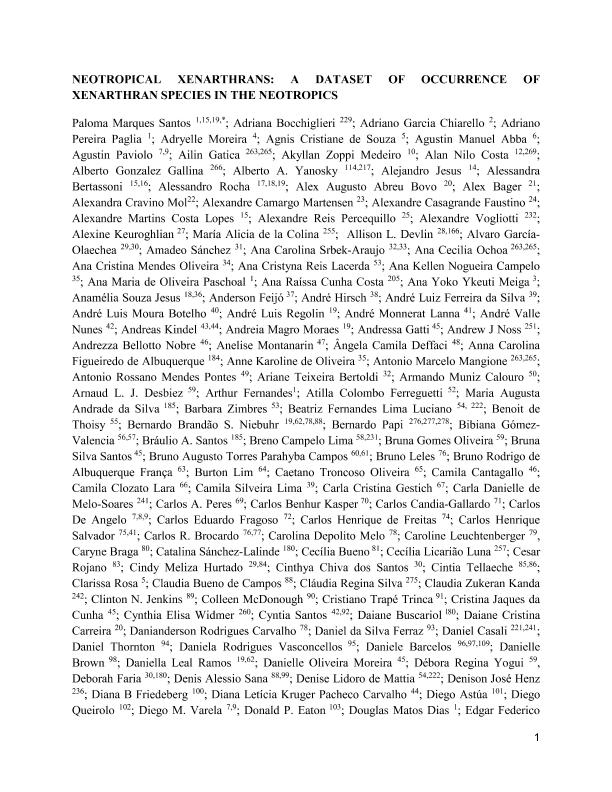Artículo
Neotropical xenarthrans: a data set of occurrence of xenarthran species in the neotropics
Marques Santos, Paloma; Bocchiglieri, Adriana; Garcia Chiarello, Adriano; Pereira Paglia, Adriano; Moreira, Adryelle; Abba, Agustin Manuel ; Paviolo, Agustin Javier
; Paviolo, Agustin Javier ; Gatica, Ailin
; Gatica, Ailin ; Ochoa, Ana Cecilia
; Ochoa, Ana Cecilia ; de Angelo, Carlos Daniel
; de Angelo, Carlos Daniel ; Tellaeche, Cintia Gisele
; Tellaeche, Cintia Gisele ; Varela, Diego Martin
; Varela, Diego Martin ; Vanderhoeven, Ezequiel Andres
; Vanderhoeven, Ezequiel Andres ; Caruso, María Flavia
; Caruso, María Flavia ; Arrabal, Juan Pablo; Iezzi, María Eugenia
; Arrabal, Juan Pablo; Iezzi, María Eugenia ; Di Bitetti, Mario Santiago
; Di Bitetti, Mario Santiago ; Cruz, Paula Andrea; Reppucci, Juan Ignacio
; Cruz, Paula Andrea; Reppucci, Juan Ignacio ; Benito Santamaria, Silvia; Quiroga, Verónica Andrea
; Benito Santamaria, Silvia; Quiroga, Verónica Andrea ; Di Blanco, Yamil Edgardo
; Di Blanco, Yamil Edgardo ; Marás, Gustavo Arnaldo
; Marás, Gustavo Arnaldo ; Camino, Micaela
; Camino, Micaela ; Perovic, Pablo Gastón; Martínez Pardo, Julia
; Perovic, Pablo Gastón; Martínez Pardo, Julia ; Costa, Sebastián Andrés
; Costa, Sebastián Andrés ; Pinheiro, Fabiana; Volkmer de Castilho, Pedro; Bercê, William; Camara Assis, Julia; Rodrigues Tonetti, Vinicius; Alves Eigenheer, Milene; Chinem, Simonne; Honda, Laura K.; Bergallo, Helena de Godoy; Alberici, Vinicius; Wallace, Robert; Ribeiro, Milton Cezar; Galetti, Mauro
; Pinheiro, Fabiana; Volkmer de Castilho, Pedro; Bercê, William; Camara Assis, Julia; Rodrigues Tonetti, Vinicius; Alves Eigenheer, Milene; Chinem, Simonne; Honda, Laura K.; Bergallo, Helena de Godoy; Alberici, Vinicius; Wallace, Robert; Ribeiro, Milton Cezar; Galetti, Mauro
 ; Paviolo, Agustin Javier
; Paviolo, Agustin Javier ; Gatica, Ailin
; Gatica, Ailin ; Ochoa, Ana Cecilia
; Ochoa, Ana Cecilia ; de Angelo, Carlos Daniel
; de Angelo, Carlos Daniel ; Tellaeche, Cintia Gisele
; Tellaeche, Cintia Gisele ; Varela, Diego Martin
; Varela, Diego Martin ; Vanderhoeven, Ezequiel Andres
; Vanderhoeven, Ezequiel Andres ; Caruso, María Flavia
; Caruso, María Flavia ; Arrabal, Juan Pablo; Iezzi, María Eugenia
; Arrabal, Juan Pablo; Iezzi, María Eugenia ; Di Bitetti, Mario Santiago
; Di Bitetti, Mario Santiago ; Cruz, Paula Andrea; Reppucci, Juan Ignacio
; Cruz, Paula Andrea; Reppucci, Juan Ignacio ; Benito Santamaria, Silvia; Quiroga, Verónica Andrea
; Benito Santamaria, Silvia; Quiroga, Verónica Andrea ; Di Blanco, Yamil Edgardo
; Di Blanco, Yamil Edgardo ; Marás, Gustavo Arnaldo
; Marás, Gustavo Arnaldo ; Camino, Micaela
; Camino, Micaela ; Perovic, Pablo Gastón; Martínez Pardo, Julia
; Perovic, Pablo Gastón; Martínez Pardo, Julia ; Costa, Sebastián Andrés
; Costa, Sebastián Andrés ; Pinheiro, Fabiana; Volkmer de Castilho, Pedro; Bercê, William; Camara Assis, Julia; Rodrigues Tonetti, Vinicius; Alves Eigenheer, Milene; Chinem, Simonne; Honda, Laura K.; Bergallo, Helena de Godoy; Alberici, Vinicius; Wallace, Robert; Ribeiro, Milton Cezar; Galetti, Mauro
; Pinheiro, Fabiana; Volkmer de Castilho, Pedro; Bercê, William; Camara Assis, Julia; Rodrigues Tonetti, Vinicius; Alves Eigenheer, Milene; Chinem, Simonne; Honda, Laura K.; Bergallo, Helena de Godoy; Alberici, Vinicius; Wallace, Robert; Ribeiro, Milton Cezar; Galetti, Mauro
Fecha de publicación:
07/2019
Editorial:
Ecological Society of America
Revista:
Ecology
ISSN:
0012-9658
e-ISSN:
0012-9658
Idioma:
Inglés
Tipo de recurso:
Artículo publicado
Clasificación temática:
Resumen
Xenarthrans -anteaters, sloths, and armadillos- have essential functions for ecosystem maintenance, such as insect control and nutrient cycling, playing key roles as ecosystem engineers. Because of habitat loss and fragmentation, hunting pressure, and conflicts with domestic dogs, these species have been threatened locally, regionally, or even across their full distribution ranges. The Neotropics harbor 21 species of armadillos, 10 anteaters, and 6 sloths. Our data set includes the families Chlamyphoridae (13), Dasypodidae (7), Myrmecophagidae (3), Bradypodidae (4), and Megalonychidae (2). We have no occurrence data on Dasypus pilosus (Dasypodidae). Regarding Cyclopedidae, until recently, only one species was recognized, but new genetic studies have revealed that the group is represented by seven species. In this data paper, we compiled a total of 42,528 records of 31 species, represented by occurrence and quantitative data, totaling 24,847 unique georeferenced records. The geographic range is from the southern United States, Mexico, and Caribbean countries at the northern portion of the Neotropics, to the austral distribution in Argentina, Paraguay, Chile, and Uruguay. Regarding anteaters, Myrmecophaga tridactyla has the most records (n = 5,941), and Cyclopes sp. Have the fewest (n = 240). The armadillo species with the most data is Dasypus novemcinctus (n = 11,588), and the fewest data are recorded for Calyptophractus retusus (n = 33). With regard to sloth species, Bradypus variegatus has the most records (n = 962), and Bradypus pygmaeus has the fewest (n = 12). Our main objective with Neotropical Xenarthrans is to make occurrence and quantitative data available to facilitate more ecological research, particularly if we integrate the xenarthran data with other data sets of Neotropical Series that will become.
Archivos asociados
Licencia
Identificadores
Colecciones
Articulos(CCT - NORDESTE)
Articulos de CTRO.CIENTIFICO TECNOL.CONICET - NORDESTE
Articulos de CTRO.CIENTIFICO TECNOL.CONICET - NORDESTE
Articulos(IBS)
Articulos de INSTITUTO DE BIOLOGIA SUBTROPICAL
Articulos de INSTITUTO DE BIOLOGIA SUBTROPICAL
Citación
Marques Santos, Paloma; Bocchiglieri, Adriana; Garcia Chiarello, Adriano; Pereira Paglia, Adriano; Moreira, Adryelle; et al.; Neotropical xenarthrans: a data set of occurrence of xenarthran species in the neotropics; Ecological Society of America; Ecology; 100; 7; 7-2019; 1-122
Compartir



